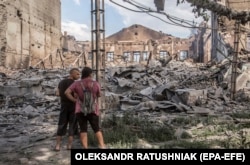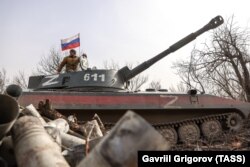As NATO leaders gather in Madrid for a key summit that will focus on Russia’s invasion of Ukraine, Russian forces are continuing to make incremental gains in the war.
Government troops are still defending Lysychansk, the last city held by Kyiv in the eastern Luhansk Province. But with no end in sight to the war, the transatlantic military alliance is looking to devise a long-term strategy to help Ukraine and punish Russia. Kyiv has pleaded for continued support, including Western arms and ammunition, to help it expel Russian forces from the country before winter bogs down forces on both sides.
Kyiv says that it remains outgunned on the battlefield, with the Russian advance now covering about 20 percent of the country’s territory. In the eastern Donbas region, composed of the provinces of Luhansk and Donetsk, Ukrainian troops are believed to be outgunned by 10-to-1 in artillery. Tens of thousands of Ukrainians are estimated to have been killed since the war broke out in February.
Meanwhile, Russian forces are making small gains in eastern Ukraine, where Moscow has concentrated most of its forces. But Western intelligence predictions say that Moscow may soon exhaust its combat capabilities and be forced to halt its costly offensive.
To find out more, RFE/RL spoke with Mick Ryan, a retired major general in the Australian Army and a fellow at the Washington-based Center for Strategic and International Studies.
RFE/RL: It appears that the Russians are making headway in eastern Ukraine, but there're also a lot of warnings and commentary, especially coming from Western officials, saying that they only believe that Russia can sustain its current momentum and pace for the next few months. Taken together, what does that mean to you moving forward?
Mick Ryan: It means that both the Russians and Ukrainians are reaching a point where their forces are pretty tight, where both of them have been slugging it out in the north, the northeast, the south, and the east for over four months now. At the individual level, but also at the strategic level, both sides are getting weary in [the] Donbas, where the Russians have focused the majority of their combat power since about Day 50 or 55 of this war.
This has really been a crucible event for both the Russians and the Ukrainians, and this has allowed the Russians to actually make some progress in the war, which they really haven't made up until this point. It demonstrates that they've learned from some of their failures north of Kyiv and around [the northeastern city of] Kharkiv and are still focused on achieving some of the political outcomes that [Russian President Vladimir] Putin set out in his May 9 [Victory Day] speech.
The Russians have been able to generate a significant advantage in artillery firepower and in air power for the first time, while the Ukrainians haven't been able to interrupt [Russian] supply lines to the same degree that they were able to do earlier in the war. So, we're at a point now where the Russians have improved.
The Ukrainians are getting a bit tired and being careful. They don't want to get drawn into a war of attrition any more than they have to because they can’t win a war of attrition against the Russians. The Russians like fighting that way -- it’s their preferred way of war -- and I think the Ukrainians are clever enough not to get drawn into fighting their adversary the way they want to be fought, but they have to be very careful at the moment.
RFE/RL: How do you avoid something like getting pulled into a war of attrition?
Ryan: The political element comes to the forefront here because there is a political desire [from Kyiv] to not cede too much Ukrainian territory. They've already lost about 20 percent of their territory so far in this war.
In particular, Syevyerodonetsk in the east represented the last major Ukrainian-held city in [Luhansk] Province. There certainly would have been political pressure to retain that city and retain that territory, but the reality is that sometimes you have to give up territory if you want to keep your army intact.
For Ukraine at the moment, preserving their army is way more important than territory, so they need to be sure not to be fighting on Russia’s terms.
RFE/RL: In a lot of the analysis that's out there, the view seems to be that the Ukrainians actually have quite a difficult time retaking a lot of territory. What does Ukraine need to do in order to launch some more successful counterattacks and retake territory in the south or in the Donbas?
Ryan: We're in a different phase of the war now. At the beginning, particularly when things were focused north of Kyiv and around Kharkiv, both sides were still learning and blowing out the cobwebs from their institutions that hadn't fought big wars for a long time.
The Russians, in particular, learned some very tough lessons about combined arms, air defense, logistics, and electronic warfare, among other things. They do appear to have learned at least some lessons and they are applying them in the east where they have really concentrated their combat power to generate a significant combat advantage against the Ukrainians.
In the south, the Ukrainians have been taking back land, but it's been a tough fight. There's a couple of reasons for that. First, this is not the main Ukrainian effort at the moment, so they aren’t getting the reserves and reinforcements that they need to make the operational breakthroughs that their tactical advances might enable.
Second, the Russians have had time to prepare multiple defensive lines in the south, and if you are fighting from prepared defensive positions, coupled with a pretty good sensor network and artillery and long-range strike advantages, you're going to make it pretty tough for an attacker to push through those multiple defensive lines.
RFE/RL: There're a lot of questions going around right now about sustainability and how long this war can really be fought by either side. It seems that sooner or later, we're going to reach a point where this is going to feel a bit difficult to maintain for both parties. Is that a realistic thing to expect? If so, how long until we reach this point?
Ryan: This is an existential fight for Ukraine.
This isn't one they chose, and it's one they would prefer not to have to fight, but they know from how the Russians have treated Ukrainian civilians, how they've destroyed Ukrainian cities, how they've raped, tortured, and murdered Ukrainians, that this is truly an existential fight for their country. It’s also one that President Putin has essentially said is a war of conquest.
So far, Ukrainians are retaining the will to fight for as long as they need to in order to ensure the Russians aren't able to subjugate them, and they have some of the resources to do that. If they keep getting supported by the West, they can continue.
But Russia is also a country that has about 100 million more citizens [than Ukraine] and is able to generate a larger military and resources to fight. It certainly has its own problems, but both sides can keep this war going for quite some time.
RFE/RL: Looking ahead, what are the key things that you're watching and that you think are important for people to follow?
Ryan: It's quite likely that Russia will close the Luhansk pocket and the Ukrainians will lose that territory or cede it.
After that, the big question is whether the Russians have the reserves to maintain their momentum and continue offensive activities in Donetsk? Or will they need to have some kind of operational pause to reset and reinforce?
I'm also looking at the south. If the Russians successfully take all of Luhansk, they'll have to make a choice about some of the critical resources -- artillery, airpower, or electronic warfare -- and whether they use them to defend that area around [the city of] Kherson in the south or do they use them to maintain the offensive in the east or, indeed, around Kharkiv? Do they want to continue to attempt to push the Ukrainians back from the Russian borders?
So, the Russians in the next month or two have some interesting challenges ahead of them. They have some big choices to make about the prioritization of ground forces, and this doesn't even include other strategic challenges that they’re facing.












